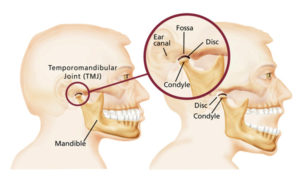What is the TMJ?
Your jaw is made up of two temporomandibular joints (TMJ).
This is where the mandible (jaw bone) connects with your skull on either side in a sliding hinge joint.
There are several muscles, ligaments and fibrous tissues that contribute to both passive and active stabilisation of the TMJ.
These structures also connect into your ears, neck and face.
Dysfunction in the TMJ or surrounding muscles can cause pain in your face, neck, and result in headaches.

What causes TMJ pain?
TMJ pain can be due to the joint itself or due to the surrounding muscles, and this pain is often experienced during chewing or speaking.
Sometimes this pain is associated with clicking, locking, popping or grating sensations as well as reduced jaw opening or closing ability.
Often TMJ pain is accompanied by teeth grinding and tight neck muscles, and these factors are important when considering your individualised treatment plan.
How can we manage TMJ pain?
For most people, TMJ pain can be managed with manual therapy and exercise.
Treatment usually involves:
- Manual therapy of joint and surrounding muscles in TMJ and neck
- Exercises to help regain jaw opening, and regain normal function of surrounding muscles
- Self management strategies to use at home (release of muscles and pain management)
We can also include other modalities such as dry needling to assist in pain relief.
If you are experiencing jaw pain, come in for a consult today, so we can assess you and create an individualised treatment plan to help you get on top of your pain and back to everyday life.
References
- Chang, C., Wang, D., Yang, M., Hsu, W., & Hsu, M. (2018). Functional disorders of the temporomandibular joints: Internal derangement of the temporomandibular joint. The Kaohsiung Journal Of Medical Sciences, 34(4), 223-230. doi: 10.1016/j.kjms.2018.01.004
- Delgado de la Serna, P., Plaza-Manzano, G., Cleland, J., Fernández-de-las-Peñas, C., Martín-Casas, P., & Díaz-Arribas, M. (2019). Effects of Cervico-Mandibular Manual Therapy in Patients with Temporomandibular Pain Disorders and Associated Somatic Tinnitus: A Randomized Clinical Trial. Pain Medicine, 21(3), 613-624. doi: 10.1093/pm/pnz278
- Gil-Martinez, A., Paris-Alemany, A., López-de-Uralde-Villanueva, I., & La Touche, R. (2018). Management of pain in patients with temporomandibular disorder (TMD): challenges and solutions. Journal Of Pain Research, Volume 11, 571-587. doi: 10.2147/jpr.s127950
- Li, D., & Leung, Y. (2021). Temporomandibular Disorders: Current Concepts and Controversies in Diagnosis and Management. Diagnostics, 11(3), 459. doi: 10.3390/diagnostics11030459

